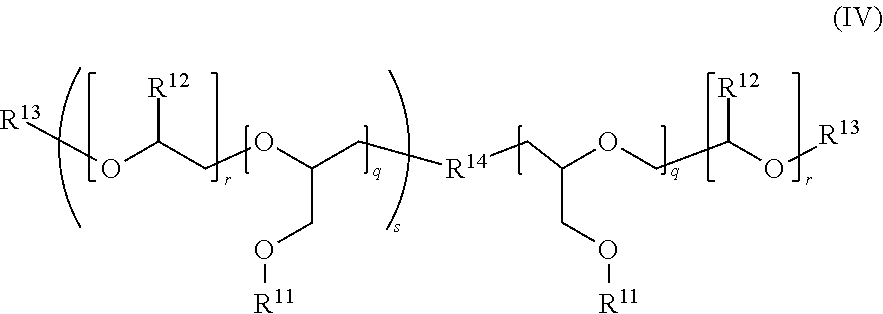Crosslinkable silicone mixtures containing a guanidine catalyst and an adhesion promoter
a silicone mixture and catalyst technology, applied in the field of two-component silicone compositions, can solve the problems of poor adhesion, poor miscibility of silicone polysiloxane matrix, and inability to bind to silicone, and achieve good adhesion and poor storage stability
- Summary
- Abstract
- Description
- Claims
- Application Information
AI Technical Summary
Benefits of technology
Problems solved by technology
Method used
Image
Examples
example 1
on of a Diguanidino-PDMS Catalyst
1,1′-(α,ω-n-propylpoly(dimethylsiloxane))-bis(2,3-dicyclohexylguanidine)
[0191]In a round-bottom flask, 16.90 g of α,ω-bis(3-aminopropyl)poly(dimethylsiloxane) having an average molecular weight of about 1050 g / mol (Wacker AMinol SLM 92503, Wacker; amine value 109 mg KOH / g) and 6.18 g of N,N′-dicyclohexylcarbodiimide are mixed and the mixture is heated to 120° C. while stirring. At regular intervals, the reaction mixture was analyzed by means of FT-IR spectroscopy. After 17 hours, the carbodiimide band at about 2120 cm−1 had disappeared completely. This gave a colorless, odorless oil having a viscosity at 20° C. of 436 cP.
[0192]FT-IR: 2961, 2930, 2855, 1647 (C═N), 1449, 1411, 1364, 1258, 1011, 862, 788, 700 cm−1.
example 2
on of the Zn-Acetamide Catalyst
[0193]316.4 g of ethyl 3-oxohexanoate and 310.18 g of dibutylamine were weighed into a 1 L round-bottom flask. This mixture was then put on a rotary evaporator at 110° C. and 300 mbar for 26 h. Thereafter, the vacuum was reduced to the minimum. The intermediate (=ligand) was then purified by means of vacuum distillation (120° C., 0.5 mbar).
[0194]11.10 g of zinc acetylacetonate hydrate were dried under high vacuum at 80° C. overnight, resulting in 10.023 g of zinc acetylacetonate (white powder). 20.06 g of ligand (2.19 eq.) were added to the powder and the mixture was heated to 100° C. for 4 h. Thereafter, the temperature was reduced to 60° C. and was maintained under high vacuum overnight. The result is a yellowish oil with zinc content 11%.
Example 3 Describes the Preparation of a Polymer Component A
[0195]The exact composition of the polymer component A (example 3), in % by weight, based on the overall component A, is shown in table 1.
[0196]
TABLE 1All ...
example 3
on of the Polymer Component A
[0197]In a 5 L planetary mixer (Hermann Linden Maschinenfabrik), dihydroxy-terminated PDMS having a viscosity of 20'000 cP (1500 g, FD 20 polymer—Wacker Chemie, Germany) was mixed with a di-TMS-terminated PDMS having a viscosity of 100 cP (300 g) for 5 min (dissolver speed: 300 rpm, kneader speed: 70 rpm). Ground calcium carbonate (900 g, Carbital 110, Imerys) was added at reduced mixing speed. On completion of addition, the mixing speed was restored (dissolver: 300 rpm, kneader: 70 rpm) and maintained for 5 min. The mixing speed was reduced again and precipitated calcium carbonate (675 g, Hakuenka CCR-S10, Omya) was added. The mixture was homogenized at 400 rpm (dissolver) and 80 rpm (kneader) under reduced pressure (100 mbar) for 5 min. The polymer component was transferred to polypropylene cartridges and stored at 23° C.
PUM
| Property | Measurement | Unit |
|---|---|---|
| temperature | aaaaa | aaaaa |
| viscosity | aaaaa | aaaaa |
| temperature | aaaaa | aaaaa |
Abstract
Description
Claims
Application Information
 Login to View More
Login to View More - R&D
- Intellectual Property
- Life Sciences
- Materials
- Tech Scout
- Unparalleled Data Quality
- Higher Quality Content
- 60% Fewer Hallucinations
Browse by: Latest US Patents, China's latest patents, Technical Efficacy Thesaurus, Application Domain, Technology Topic, Popular Technical Reports.
© 2025 PatSnap. All rights reserved.Legal|Privacy policy|Modern Slavery Act Transparency Statement|Sitemap|About US| Contact US: help@patsnap.com



